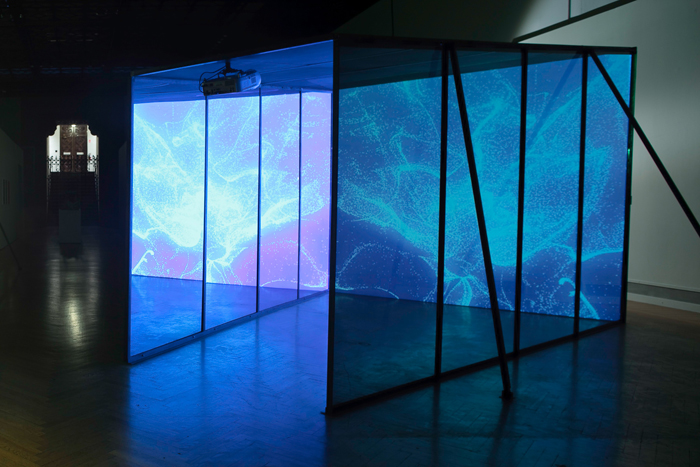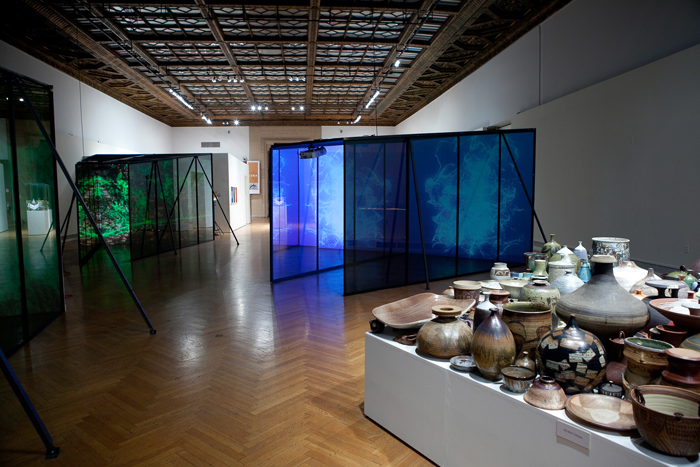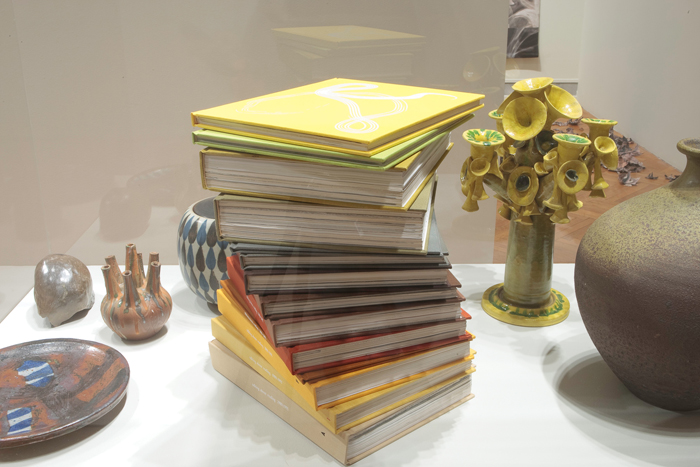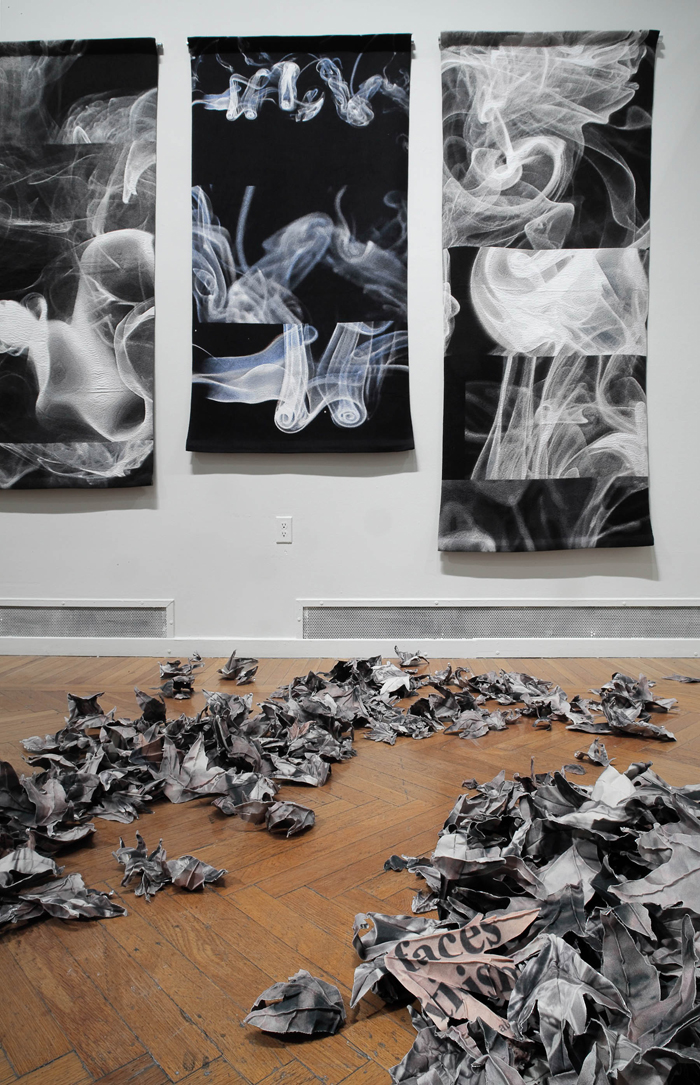Pae White’s thought-provoking exhibition, In Between the Inside-Out, challenges conventional dichotomies such as art/craft and machine-made/hand-made with works that invoke ontological uncertainty and prompt the viewer to revisit ideas about illusion in representation. The diverse pieces, which include large-scale video installations, scatterings of trompe l’oeil leaves, wall works on fabric, and arrangements of ceramic objects and books, trouble conventional categories by keeping the viewer guessing as to their true identity. Are the leaves real or fake? Are the ceramic pots art or craft? By throwing familiar hierarchies into question in novel ways, the show offers a refreshingly inclusive, syncretic model of making and understanding images and objects that integrates rather than emphasizes perceived differences.
This model is advanced most spectacularly by three video projections, each encased in its own trapezoidal glass pavilion. Inspired by a residency at the FOR SITE Foundation in the Sierra foothills, the videos are based on flora found in that landscape: an 800-year-old live oak, a wild raspberry bush, and a Manzanita grove. The plants are represented using 3-D imagery created by a device similar to an MRI scanner, leaving the vegetation untouched. This concern for the organisms’ well being reflects White’s syncretic process: we are able to get “inside” a natural phenomenon without resorting to standard scientific methods of collection and dissection. For White, the plants take on something like personalities: the aged oak is a revered, sacred elder in contrast to the deciduous raspberry bush’s delicate, fleeting presence; the dense foliage of the manzanitas serves as a pervasive background.1 These different, symbolic roles are emphasized in the translation of each form into a time-based phenomenon.

Pae White, Ballerina (Wild Raspberry Bush), 2009. Digital animation, glass, steel, wood; dimensions variable. Photo: Paul Kuroda.
The resulting projections, created in collaboration with DreamWorks animators, are beautiful, hypnotic swirls of light that recall natural forms but coalesce and branch outward in mesmerizing, abstract patterns. Mirrored and refracted in the glass walls, these images multiply outward, creating panoramas to envelope the viewer. In some ways, they recall the work of Jennifer Steinkamp, whose site-specific video projections of animated flowers, trees, or cloud formations often seem to dissolve the walls of the spaces they inhabit.2 But White’s installations are more disjunctive: the reflected images overlap with other works and people in the room, creating a confusion of projected and three-dimensional space. This disorientation is furthered by the projections’ illusion of three-dimensionality, which makes their branching forms seem like apparitions in the gallery. While the limbs of Dying Oak Tree (2009) curve powerfully through what feels like vast spaces, the sprays and tendrils of Ballerina (Wild Raspberry Bush) (2009) sparkle more delicately as they turn in upon themselves. Redeeming Brown: Manzanita Grove (2009) weaves a denser web that resembles a starry nebula—an overall texture rather than a figural presence. In this sense, White transplants abstracted versions of three aspects of the Sierra landscape into the museum, bringing something of the outdoors inside.
Visually and temporally layered spaces exemplify White’s approach, proposing ways in which two different realities can appear in the same place at the same time. This interpenetration of illusion and reality invokes the in-between state suggested by the exhibition’s title and is further reinforced by the liminal function of the pavilions’ glass walls. The walls both provide the boundary between the inside and outside of the installations and the means (via reflection and transparency) for the projections to transcend that border. Their abstracted natural forms move and penetrate the rest of the exhibition space, extending the experience inside of the installations outward. The lines between illusion and reality, or inside and outside, never completely disappear in White’s work, although the concepts they delineate are thoroughly intertwined.
White’s works also bring together different modes of looking. They bridge the gap between what Carter Ratcliff has called the “old metaphysics of imaginary space” and “the metaphysics of real space” advanced by Minimalist artists such as Carl Andre and Donald Judd. Ratcliff notes that the former is not a coherent doctrine but a system of Platonic thought upon which traditional systems of representation are based.
…[I]t is the shared core of romanticism and neo-classicism, symbolism and the high-minded varieties of realism, arte metafisica and surrealism, utopian modernism and American formalism— all the aesthetic programs that promise to deliver a vision of the Real and the True.3
White’s technologically sophisticated abstractions might be considered “True” essences as determined by machines. The projections are hyper-simulations that go beyond superficial resemblance to reveal the three-dimensional structures inside of their subjects. By contrast, writes Ratcliff, “The [Minimalist] art object joined us in our world, immersed now in the contingencies that have always engulfed us.”4 The layered, in-between spaces of White’s video installations integrate both of these traditions by conjoining abstract, technological visions of natural forms with the real, contingent space of the gallery. White’s work thus pointedly ignores the Modernist avant-garde imperative to continually negate that which has come before. This gesture suggests a different impetus for artistic practice, one that is based not in an antagonistic or ironic relationship with the past, but in a cumulative, inclusive one that reconciles rather than rebukes.
These works seem at home amid the artistic currents of the 1960s and 1970s, when the status of the art object reached a crisis point with the rise of conceptual practice and artists’ (often conflicted) attempts to elide the difference between art and everyday life.5 Yet rather than trying to “dematerialize” her practice, as contemporary practitioners of relational aesthetics do, White examines the unstable categorical status of the art object in resolutely physical form. The tension between illusion and reality is embodied in drifts of leaves found on the floor at several spots in the galleries. Fabricated out of metal or canvas, all are either painted or printed to approximate the variegated color and texture of real leaves, except for one group that is finished in stark, shiny silver. Like the video projections, they bring an aspect of the outdoors inside, as if they had just blown through the door. At the same time, the leaves also reveal their fabrication: tiny spots of metal have been left exposed on some of them, creating a silvery glint that is patently unnatural.

Pae White, In Between the Inside-Out. Installation view, Mills College Art Museum, September 2–October 18, 2009. Photo: Paul Kuroda.
White’s interest in objects’ unstable identities becomes clearest in her use of ceramics, which serve as condensations of landscape, craft, and art. Literally made of earth, ceramics is one of the most ancient and “natural” art forms. White acknowledges this lineage in Five Black Nesting Bowls (2009), a group of rough, soot-colored vessels made by pressing a mixture of hand-harvested clay into centuries-old “grinding holes.” Native Americans carved these depressions into the surface of granite boulders throughout the Sierras, using them to grind acorns and seeds. By translating their well-worn contours into fired clay bowls, White creates a link between ceramics, the landscape of the Sierras, and human technology in harmony with its surroundings. As physical impressions, the bowls are also another kind of “projection,” bringing a different aspect of that landscape into the gallery. They are a synthesis of art object, craft vessel, and a material record of a particular place.
White looks more specifically at the art/ craft binary in a presentation of two large collections of ceramic works. Each group is presented on a low plinth upon which its unlabeled objects are butted up against one another. This arrangement, reminiscent of Minimalist monoliths, turns each cluster into a work of art in its own right. No dates or contextual or historical information is provided beyond the name of the collection. This treatment emphasizes the identity of the group over that of its individual pieces and leaves us with two masses of unidentified ceramics. White asks us to compare the two sets of objects on the basis of their physical characteristics rather than their provenance or historical importance. It is only through the checklist and exhibition brochure that we learn that one group, titled Massed Field, Joseph Meade Collection (2009), is a mix of art objects and thrift store finds collected by a man White met during her FOR SITE residency. The other, Massed Field, Mills College Art Museum Collection (2009), represents the college’s extensive holdings of works from the American Studio Craft Movement. Spanning the 1920s through the 1960s, this movement asserted the artistic merits of craft, such as ceramics, glassblowing, textiles, and woodworking. Bay Area artists, in particular Peter Voulkos, elevated ceramics to the level of Abstract Expressionism in the 1950s and 1960s, influenced by painters such as Willem de Kooning and Franz Kline.6 Yet although the Mills objects are somewhat larger and more colorful than Meade’s, the two fields look strikingly alike, both because they are arranged in the same way, and because they contain very similar kinds of objects. As the word “field” in her titles suggests, the installations evoke miniature topographical maps. But they also suggest ideological spaces—as in fields of study or fields of inquiry—that are delimited by discursive rather than material borders. Our physical experience of the installations contradicts the distinctions made in the textual information, making it clear that it is chiefly the imprimatur of the museum, rather than any intrinsic, perceptible quality, that designates something as art. In presenting both collections under the rubric of her own practice, White performs an act of synthesis that brings art and craft objects into a more egalitarian relationship simply by placing them next to each other.

Pae White, Talking About Reading 1989-1991 (detail), 2005. Paper, hand-bound artist books, 25 volumes, 11 x 19 inches each; unidentified ceramic objects. Photo: Paul Kuroda.
The discursive nature of White’s project emerges in a pair of glass display cases filled with bound books and a variety of additional ceramic objects from the Mills College Art Museum collection. The 25-volume set, titled Talking About Reading 1989-1991 (2005), contains White’s texts and notes from her graduate classes at the Art Center College of Design in Pasadena. The exhibition checklist notes each of the ceramic pieces as an individual work; some are by well-known artists—Voulkos, Robert Arneson, and James Melchert among them—while others are listed as “Unknown.” But the checklist does not indicate which are which, challenging viewers to discern any difference. This indeterminate labeling comes across as a playful test of sorts, rewarding, frustrating, or beguiling depending on the viewer’s perspective; but it also propels the objects into a kind of limbo, where they are neither art nor craft, but simply objects to be considered. By contrast, the thick, hardbound books suggest the increasingly professional and academic training of artists. Yet these repositories of pedagogy are treated as objects, stacked and sealed behind glass. Together with the unlabeled ceramics they form a kind of double negative: objects outside of discourse and discourse immured in objects.

Pae White, Smoke Sequence #5, 2009 (polyester, cotton; 79 x 38 inches); Smoke Sequence #7, 2009 (polyester, cotton; 73 x 38 inches); and Smoke Sequence #4, 2009 (polyester, cotton; 89 x 37 inches). On floor: Pae White, Sick Amour, 2009. Canvas, aluminum, soot; dimensions variable. Photo: Paul Kuroda.
In this way, White’s work employs a logic of proximity and embodiment rather than separation and analysis. The five hanging scrolls that comprise the series Smoke Sequence (2009) appear at first to be digital images of spiraling columns of smoke printed on dark blue-gray fabric. Although realistic, the images are interrupted by sharp horizontal breaks in the flow of the smoke, as if two adjacent photos had become misaligned—a sign, perhaps of a digital cut and paste job. However, on closer inspection the images prove to have been woven incredibly smoothly and uniformly, suggesting that they were produced mechanically rather than by hand. Although visually modest, these works achieve a dense layering of subject, process, and materials. The smoke, a byproduct of fire, could be seen as a result of human intervention in the landscape, linking it back to the Native American grinding holes.7 Smoke is also a transformation of solid material into airborne matter. As such it is a representation of an in-between state, reminiscent of the exhibition’s title and the indeterminate spaces suggested in the show’s other works. A machine reproduces a digital photograph of a physical phenomenon in a craft medium, elegantly uniting art, craft, handiwork, and machine production. In White’s art, the differences are not eradicated so much as held in tension, giving rise to an in-between state that evades categorization. In this sense, In Between the Inside-Out provides an intriguing and potentially liberating model in which differences are not merely tolerated but instead provide the generative condition that results in something new and startlingly whole.
Sharon Mizota is a writer and critic based in Los Angeles.
